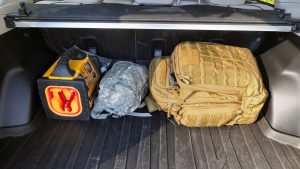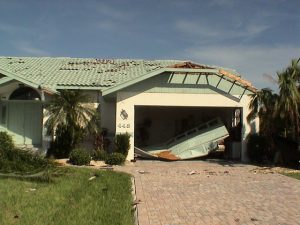We usually know about weather-related events long before they affect us. In the case of hurricanes, we’ll have as much as a week advance notification to begin preparing. Other events are random or seasonal, like plane crashes, wildfires, nuclear power plant accidents, tornadoes, torrential rains, blizzards, etc. may not give us much warning before they strike. We can anticipate when they could occur and take some of the precautionary measures below, then complete the list when the event is imminent.
 Check your “Go Bag”. Verify everything in your documents is accurate and up-to-date. Refresh your memory sticks with your recovery data. Replace all batteries with fresh ones. Fill your water bottles. Add in seasonal clothing. Replace the prescription drugs in the bag with fresh ones. If you have a solar panel, make sure your have the right connectors and plugs for it to work. Start getting your “If I have time” list of items together. If you intend to evacuate, pre-position the bag in your car.
Check your “Go Bag”. Verify everything in your documents is accurate and up-to-date. Refresh your memory sticks with your recovery data. Replace all batteries with fresh ones. Fill your water bottles. Add in seasonal clothing. Replace the prescription drugs in the bag with fresh ones. If you have a solar panel, make sure your have the right connectors and plugs for it to work. Start getting your “If I have time” list of items together. If you intend to evacuate, pre-position the bag in your car.
Top off gas tanks & fuel containers. This retains your option to run if things change later. If you have a generator, you’ll need enough fuel to run it for an hour or two per day.
Fill propane tanks. You may need to cook on your propane grill, so make sure you have extra canisters. If the event duds, you can always return them for a refund.
Fill bathtub and containers with water. After the event public water systems will fail or become contaminated with raw sewage. Fill every available container with water and cover it with saran wrap. There are bathtub bladders ($25) designed for this purpose. There are also inexpensive 20-gallon collapsible “water bags” on eBay and Amazon.
Protect glass. Use duct tape to cover all glass. Cover both sides. Your goal is to prevent a flying object from penetrating into your home. Close all storm shutters. If you have the inclination, cover windows with plywood, although any storm generating that kind of energy is likely to take off your roof, rendering window protection pointless.
Reinforce the garage door. This is best done with 2x4s and wood screws. Drive the wood screws into the frame to prevent the door from raising. Then from the outside, drive wood screws through the door into the 2x4s. Three or four across each door should be adequate. If you really want to toughen up the doors, screw plywood across the garage door openings from the outside, and secure it with wood screws every 6”.
Clean gutters and downspouts.
Notify your credit card companies that you might evacuate. Tell them where you’re likely to go so they won’t deactivate your credit cards when unusual activity is detected.
Remove debris from yard. Secure any lawn ornaments, children’s toys or loose items that could become airborne in high winds.
Secure outside furniture, gas grills, etc. Place these up close to your house, protected from the wind or put them in the garage if you have one. Tie them together with rope to prevent them from becoming airborne. Loop the rope around your deck or trees.
Pick up prescriptions. Put them in Ziploc bags and place them into your “Go bag”.
Do all laundry & dishes. No telling when water service will be restored.
 Fill Ziplocs ¾ full with water and freeze them. Locate your ice chests and keep them handy. If power fails, try to not open your freezer or refrigerator. The frozen Ziplocs will keep your food safe to eat for up to a week. If you have to evacuate, place your frozen Ziplocs and food into the ice chests. You can drink the water in the Ziplocs after it melts.
Fill Ziplocs ¾ full with water and freeze them. Locate your ice chests and keep them handy. If power fails, try to not open your freezer or refrigerator. The frozen Ziplocs will keep your food safe to eat for up to a week. If you have to evacuate, place your frozen Ziplocs and food into the ice chests. You can drink the water in the Ziplocs after it melts.
Back up your computer onto your cloud account and an external hard drive. Put the backup drive into your “go bag”.
Park your car in the garage or protected area. After the storm roads will be a mess. Once they’re cleared, you may want to evacuate if the damage to your home is severe, but anticipate slow travel, blocked roads, lack of fuel and resources in the impacted area, and flooding.
Unplug electronic equipment, to include computers, televisions, wireless routers, etc., and move them to a safe place. Even with surge protectors lightning strikes can be dangerous.
Move furniture to higher floors if you expect flooding.
Roll up carpets and throw rugs, and move them to higher floors if flooding is expected.
Make evacuation decision. This is a life or death decision so give it serious thought. You’ve done everything possible to prepare for the event. All the things you need to survive and rebuild your life is in your “go bag”. The house is just a house – easily replaced – and there are no medals handed out to “storm riders” or people killed by the storm. On the other hand, if your area is forecast to be on the fringe of the affected area, or if it is impossible to evacuate for some reason, be confident that you’ve done everything possible to insure your survival.